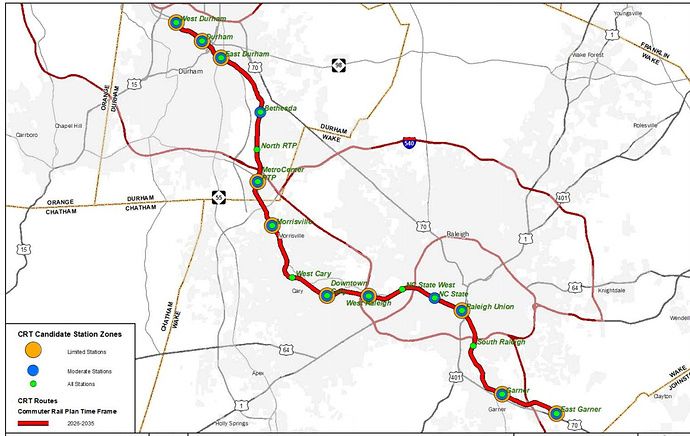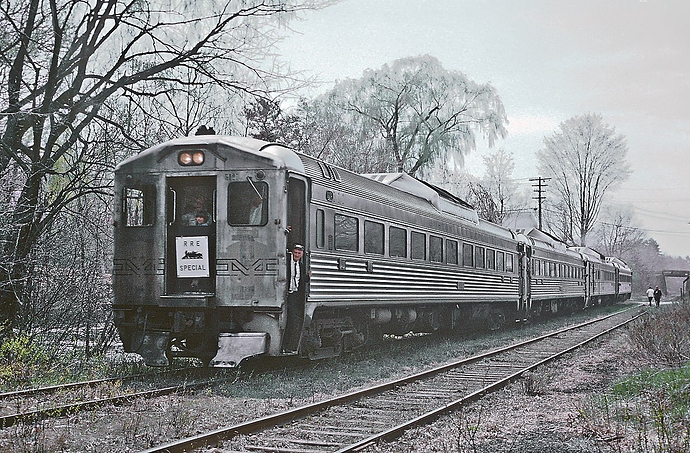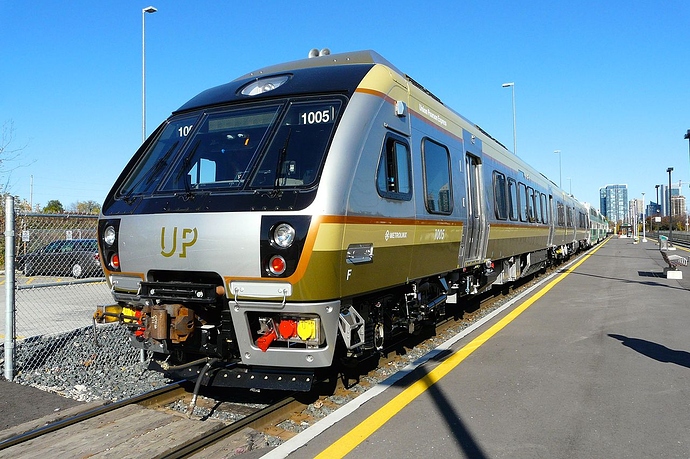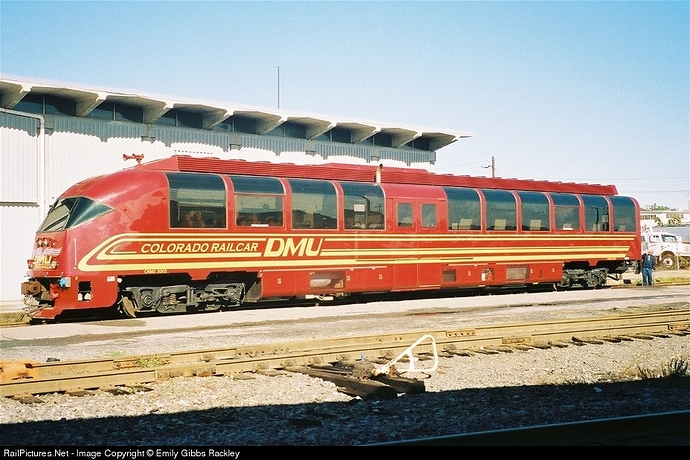Speaking off the record, it’s usually elected officials holding stuff up. We invest a lot of time and effort into a study, we get the results, we go to elected officials for approval and they say “ah ok, but can you re-do the study using these ten specific parameters I just made up on the spot to sound smart?” and then you’re back at square one forever. That’s what happened here: Wake Transit did its own Major Investment Study on the feasibility of commuter rail (Garner/West Durham segment), we got the results, and then a bunch of people decided to throw their weight around to get GoTriangle to study it again using Selma-Mebane, only to have the study apparently confirm what the Wake Transit MIS confirmed months ago. We just wasted months! Again, the problem with polycentric regionalism in a nutshell.
I agree that Hillsborough makes sense, especially considering the Amtrak station will be done by then. But again, I’m a bit fearful that every little addition decrease the possibility of it happening in the first place.
Thanks mate, appreciate that response.
Correct me if I am wrong, but they didn’t test any alternatives with better midday frequency than every… 90 or 120 minutes, right? What about an 8-3-8-3 or 8-4-8-4 option? Why was that off the table? We already know that the more biased towards peak service that an operation plan is, the more expensive it is to operate per revenue hour. The most economical service to run per revenue hour is peakless because split shifts are harder to staff and vehicles sit around idle during the midday. If ridership is lower at midday, that is at least partially offset by efficiency gains. So what is the reason for this evidently 3:1 or 4:1 peak to base ratio? 2:1 seems like it would be much better.
- Interference with freight? (If we’re going full double track, this shouldn’t be such a big thing?)
- Minimizing operating costs even at the expense of efficiency and passenger convenience?
- The bias built into the taxonomy of US transit services that “commuter rail” that shares tracks with freight are focused only on white collar downtown office workers and heavily emphasize peak service?
At any rate I am sure that 8-2-8-2 service starting some year (2027?) Is better than 8-4-8-4 service starting a year or two later, given that 8-2-8-2 can be upgraded later, too- so let’s just go with what the study says for now and talk about making it better for phase 2. I would definitely like to see some planning for an eventual frequency bump and possible future interlining with lines to Wake Forest and possibly Apex baked into the process as the project enters the engineering phase.
For those curious about the origins of 8-2-8-2, it’s actually from the Wake County Transit Plan on page 12 (https://gotriangle.org/sites/default/files/publications/november-2016-wake-transit-plan_small.pdf)
Commuter Rail Transit (CRT) is a train operating on shared tracks
with freight and Amtrak vehicles in the freight right of way.
It is envisioned to operate up to eight trips each way in each
direction during the peak hour, with one to two trips during
the midday and evening hours.
What theoretically could be done to increase trips between Durham and Raleigh is to allow GoTriangle passengers to use their passes/tickets on regular Amtrak trips between the two cities. This is an agreement that Connecticut has done with Amtrak on some of their routes:
https://shorelineeast.com/images/docs/SLE-SchedPostSep19R3.pdf#view=FitH
Amtrak accepts Shore Line East Multi-Ride tickets for ONLY the SELECT trains listed on our schedule. Shore Line East Multi-Ride tickets include: Shore Line East Monthly, UniRail, Ten-Trip or Weekly tickets but NOT single ride tickets. All one-way tickets will be charged the full Amtrak fare.
Tickets purchased at CT rail Hartford Line Ticket Vending Machines are accepted onboard all of Amtrak’s Regional and Shuttle trains between New Haven, CT and Springfield, MA - except for the Vermonter (trains 54, 55, 56, and 57). Passengers who present a CT rail ticket for travel on the Vermonter will charged at the applicable Amtrak ticket rates.
8-4-8-4 was studied and while it did produce additional projected ridership, it wasn’t enough to justify the expense. I also think NCRR and the freight companies were willing barely willing to begrudgingly play ball with 8-2-8-2, and anything more was a non-starter. A lot of what you’re saying there is correct, and I think that the Wake Forest-Raleigh-Durham alignment is something that should be next on the agenda once Garner-Durham is up and running.
I don’t personally have a problem with the 8-2-8-2 protocol since this is regional rail and not a subway.
Having looked at schedules for comparable commuter systems, i.e. Long Island Rail Road, New Jersey Transit, Metra, SunRail, TriRail, MBTA, SEPTA, LA MetroLink, and Caltrain, there is the common theme of peak running when riders are going to work from the exurbs, and peak running when heading home. So, I wouldn’t expect that our little project to be any different.
And, with any comparable metropolitan area, mid-day movement will be by bus. Not as sexy as the choo-choo. But, more economical.
As a side note, there is the growing development of reverse commuting to new job sites in the exurbs. LIRR and NJT have been struggling with what to do about this as well as MBTA. Their entire infrastructure is geared to move from outwards-in. Not the other way around.
The fact that existing commuter rail service like LIRR etc focuses mostly on suburb/exurb-to-cbd office commuters is something that should be avoided, not emulated. The service pattern we know today as commuter rail does not exist in any other countries, has its origins in an era of white flight and, essentially, transit apartheid- and this nature is still baked into the DNA of the major commuter rail agencies to this day.
Commuter rail was intentionally planned with few stops inside the city, higher fares, and poor mid-day service - in order to offer a “premium” service to a narrow, wealthier-than-average, whiter-than-average clientele, and to intentionally exclude “those people” who lived in the cities who railroads figured would make their real customers uncomfortable. I’m not making this up.
Now, these suburb to CBD commuters are the bread and butter of rail systems worldwide, and frequencies being higher at rush hour than midday is fairly common even overseas, but the difference is that we should be striving to create something that is broadly useful to a much wider cross section of society. Make something that’s useful to service workers, health care workers, construction workers, etc in addition to the 9-5 office workers, and they’ll ride it too.
Of all the agencies in North America Denver RTD started from scratch with that mindset; Caltrain and Metrolinx(Toronto) are earnestly pursuing it; Metra is toying with the idea for some of its lines on the south side (if the mayor and county board president can bury the hatchet and move past a petty turf battle). Nobody else is taking it seriously and it’s a tragedy. Let’s hop on board and grow these ranks!
With regards to federal funding, I’m sure # and location of stops/stations is an ultimately salient design characteristic.
Do we know what we’re getting yet? To your point above, the more stops, the more useful for all people, but less convenient for long exurb commuters.

But there is always the option to have lots of stops, with some trains stopping at each one, and some express trains only stopping at the 3-4 larger stops.
I dig looking at that proposed commuter rail map for the Triangle, but I just hate that it misses so much of the region that actually needs it. Like NORTH RALEIGH. Shoot, it doesn’t even make out to northern I-440, and no where near northern I-540.
I get that it has to follow where the train tracks are now, so it basically follows Hwy 54 for most of it’s Wake County path. Uhhg. You’re in luck if want to go from Downtown Raleigh to Morrisville! lol
True… but with less frequent (commuter) service, a more delicate balance will need to be struck between platform usage during peak times. That seems like a very long term goal for our primordial system
They did run models with different station quantities and found that a middle-of-the-road approach had the best ridership. With too many stations, the time savings of commuter rail vs. driving are eliminated, and with too few you’re limiting your geographic scope, which you alluded to above.
Skip-stop or local/express only works if you have at least triple-tracking through the extent of the corridor, and perhaps quadruple tracking since we have bi-directional peak flow along the proposed corridor. It makes sense for major cities like Chicago, DC, etc. where >60% of your trips are headed in one direction or the other during those times.
Thanks Kevin. So likely the NC State stop, but not south Raleigh or W NC state
Thing is, if we electrified and ordered EMU trains (which is what is being done by the four US agencies I mentioned above, as well as by literally everywhere else overseas, including places both substantially poorer and less populous than us), we could possibly as much as double the number of stops within the urban core, while maintaining comparable running time. This is because electric multiple unit trains accelerate so much faster than standard issue US commuter trains. (DMUs provide some, but not all, of this benefit over conventional trains.) Imagine putting rail stops at everywhere on that map, plus South Park (Hoke St), Memorial Auditorium (Kindley Street), West Morgan, Gorman, Jones Franklin, Chatham Square (NE Maynard)… toss in a North Raleigh line with stops every .75-1.5 miles and …
I realize this is not in the cards at this point, but if we articulate this as our vision and plot out a path to execute it… this sort of vision has the power to change peoples’ minds and cause a seismic shift in development patterns.
“But @orulz,” you say, “20 stops between Raleigh and Durham? No way I’m going to sit through that!”
To that, I say… perhaps 20 is an absolute upper bound, but 5 intermediate stops in the “limited” stations option is so few as to be of very “limited” use. The 10 intermediate stops in the “all stations” option is getting closer, but it still leaves a lot on the table, especially within the densest parts of Raleigh.
Modern euro-spec urban EMUs can lose just a bit more than 1 minute per stop, including dwell time (from when they first put on the brakes to slow down for a stop, to when they are back up at their top speed of 70 MPH or whatever). So you could still make it from Raleigh to Durham in around an hour, even with all those stops.
Hmmm? I’ve probably missed something here. I thought that the whole Wake Transit Plan commuter rail was going to be home funded. I didn’t think that we were going to chase after federal New Starts money again.
[Update: I guess I answered my question. We’re going for FTA Core Investment Grant funding. Oy!]
And, here’s the Power Point presentation made by GoTriangle updated today…
Take away message: ‘The North Carolina Railroad is built for the service it currently offers. Added capacity, including commuter rail, would require additional infrastructure, including added tracks.’
This would be potentially up to 37 miles of added track capacity for the NCRR granted through GoTriangle. Kinda huge as it would be a win-win for both agencies because it would be expected that the commuter rail equipment would meet FRA’s 49 CFR Part 238 regulation and share the line - whether it be DMU or engine-pulled coaches. GoTriangle would get priority scheduling on their track. And, NCRR will get some additional line capacity through Wake and Durham counties.
This was where TTA Regional Rail and DOLRT were both totally screwed due to their planned use of FRA 49 CFR Part 238 non-compliant equipment. Both systems would have encroached on the host railroad’s rights-of-way with no benefit to the freight carrier.
And, Duke doesn’t have a single thing to say about this.
We just might see this happen!!!
Now, on to equipment - Diesel Multiple Units
The Budd Rail Diesel Car, RDC or Buddliner is a self-propelled diesel multiple unit (DMU) railcar. Between 1949 and 1962, 398 RDCs were built by the Budd Company of Philadelphia, Pennsylvania, United States. The cars were primarily adopted for passenger service in rural areas with low traffic density or in short-haul commuter service, and were less expensive to operate in this context than a traditional diesel locomotive-drawn train with coaches. The cars could be used singly or coupled together in train sets and controlled from the cab of the front unit. The RDC was one of the few DMU trains to achieve commercial success in North America. RDC trains were an early example of self-contained diesel multiple unit trains, an arrangement now in common use by railways all over the world.
Budd RDCs were sold to operators in North America, South America, Asia, and Australia. They saw extensive use in the Northeast United States, both on branch lines and in commuter service. As passenger service declined in the United States the RDC was often the last surviving conveyor of passengers on a particular route. Most RDCs were retired by the 1980s. In Canada, RDCs have remained in continuous use since their introduction in the 1950s. The RDC inspired several derivatives, including the unsuccessful Budd SPV-2000. The New York Central Railroad strapped two jet engines to an RDC in 1966 and set a United States speed record of 184 mph, although this experimental configuration was never used in regular service.
A railfan favorite, the RDC’s have enjoyed a surprisingly long service life with legacy units still being used, the last being in Vermont which has yet to get started in active service.
In 2011, the Federal Railroad Administration established a new set of safety guidelines regarding passenger rail equipment operating in territories where they operate with freight equipment. This directly impacts Amtrak as well as agencies operating commuter service. Canada has adopted similar crash-worthiness guidelines as well.
Even when there is zero possibility of a passenger train colliding with a freight train, FRA buffering regulations still apply. These days, there are virtually no freight trains running on the Caltrain line, but Caltrain must still run its fleet to those specifications because the line connects to the national rail network.
The situation also applies to the Long Island Rail Road (LIRR) in New York City, which has no freight traffic and a modern, automatic train control system to prevent collisions. Technically, it is still a freight railroad subject to FRA rules. Thus, the new M-7 railcars purchased by the New York MTA weighing in at 125,000 lbs – twice the weight of a non-FRA compliant BART car on the off-chance an LIRR might collide with a 100-ton coal train.
So, with that in mind, there have been three different DMU’s which have been built and operated in North America.
The Nippon Sharyo DMU is a model of diesel multiple unit passenger train designed and manufactured by Nippon Sharyo for the North American market, and compliant with FRA Tier 1 crash-worthiness standards. 18 pairs have been delivered to Sonoma–Marin Area Rail Transit (SMART) in Sonoma and Marin Counties, California, and 18 pairs are in use by Metrolinx for the Union Pearson Express airport link in Toronto, Ontario. These were built at a new facility in Rochelle IL which eventually closed in October 2018 due to a lack of orders.
Colorado Railcar developed another DMU for the North American market, and one agency purchased sets for use – Portland Tri-Met for their WES (Westside Express Service) Commuter Rail. Three pairs were delivered as Colorado Railcar went through bankruptcy, and the agency supplemented their fleet with two Budd RDC’s.
US Railcar has purchased the assets of Colorado Railcar, and is based in Columbus OH. But, with the failure of the 3-C (Cleveland, Columbus, Cincinnati) service, US Railcar has no manufacturing facility nor delivered units.
Colorado Railcar’s demo unit…
A Colorado Railcar DMU in service in Portland OR
Stadler Rail of Switzlerland has their GTW model of DMU which has demonstrated a certain degree of success in the North American market. These have been deployed on New Jersey Transit’s River Line, Austin’s Capital MetroRail, Denton County Texas’ A-Train, and East Bay California’s eBART service.
A Stadler GTW in Trenton NJ…
Stadlers are what we need. I like the FLIRT because it comes in a bi-mode (diesel/electric). The highest floors they offer off the shelf are 30" though, so we’d have to get them to raise the floors by a foot and a half.
I really have to think that at those costs (ranging $1.4 to $3.2 billion??) we should at least be able to hang some bloody electric wires.
Has there been any discussion of who will be the implementing agency? GoTriangle, NCRR, or NCDOT Rail would all seem to be candidates. NCDOT Rail has the best track record and most experience, having implemented the Piedmont Improvement Program.
Electrification probably won’t happen anytime soon. Caltrain’s modernization along 51 miles of the peninsula is projected to cost $1.9B. The Federal Transit Administration’s Capital Improvement Grant program has only delivered $372M through FY2019. And, they’re only going to get $100M for FY2020.
So, the federal grant allowance is only going to be 33.5% of what’s required with the rest being local/state funding.
FTA CIG fy20-annual-report.pdf (344.6 KB)
The thing about GoTriangle’s report is that it only showed the end-points regarding the possible federal funding equation and rating.
Having done my fair share of meta-analyses when in graduate school, I do better with the raw data in looking for other end-points to assist in decision analysis. That’s something which won’t show up until the final environmental impact statement (FEIS).




